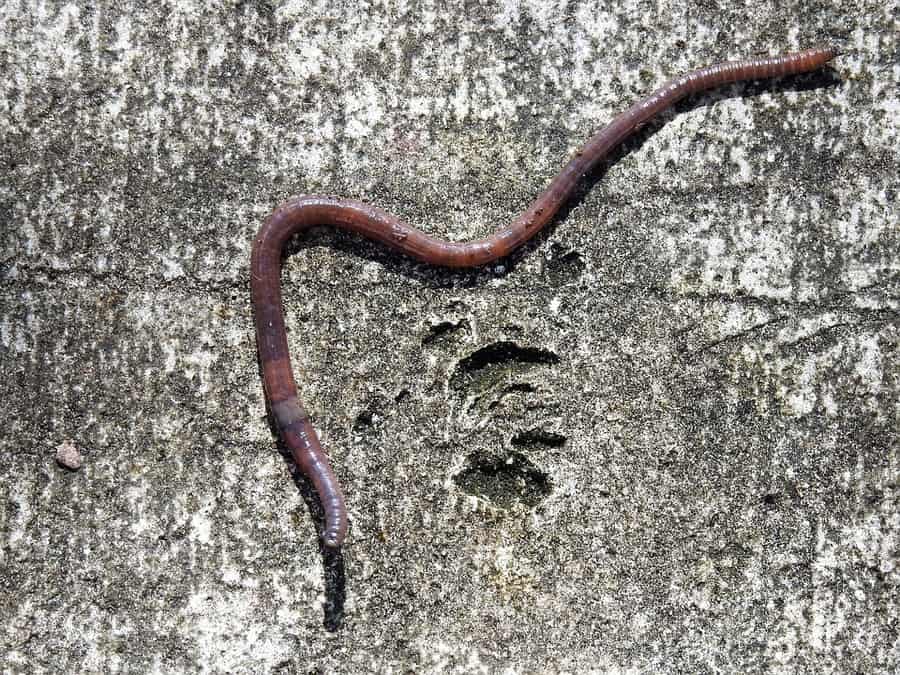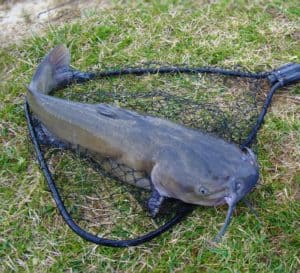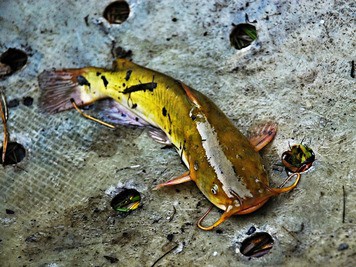Worms as Catfish Bait (Nightcrawlers, Worms, Wigglers)
Leave a comment after this article and let’s talk more about fishing. I’d love to read your feedback.
Can you catch catfish with worms? You can catch catfish using worms. Worms provide fish-attracting scent and enough natural action to draw in fish day or night. The effectiveness of worms makes them one of the most popular catfish baits.
While you may luck into a stringer full of catfish by haphazardly tossing worm-baited hooks into the abyss, there are specific ways to ensure bites and action using worms. Read on to learn how to maximize your catfish success.

Table of Contents
Worms as Catfish Bait
Table: Worms as Catfish Bait
| Bait Type | Preparation | Target Catfish Species | Best Applications |
|---|---|---|---|
| Nightcrawlers | Whole or in pieces | Channel, Blue, Flathead | Bottom fishing, suspended under a bobber. Often used with a weight to keep the bait near the bottom. |
| Red Wigglers | Whole, often used in smaller sizes | Channel, Blue | Effective in shallow waters or for smaller catfish. Can be used on a smaller hook. |
| European Nightcrawlers | Whole or halved | Channel, Blue, Flathead | Versatile for various depths; effective in still and moving waters. Good for larger hooks. |
| Manure Worms | Whole, suitable for smaller hooks | Channel, Blue | Ideal for areas with smaller catfish or in heavily fished waters where smaller bait is more effective. |
| Catalpa Worms | Whole, can be live or frozen | Channel, Blue, Flathead | Surface or near-surface fishing; known for their strong scent and appeal to catfish. |
Worms are actually the perfect catfish bait for a variety of reasons. They are readily available everywhere and in every garden or bait shop.
They are free or very inexpensive depending on your means of acquiring them. They also offer great longevity and hardiness.
But we don’t care about all that. What we really care about is how to catfish like them. Catfish devour worms given the opportunity.
Sure there are plenty of bait options (cut bait, live bluegills, chicken liver, etc) that work really well under certain circumstances, but worms will catch catfish under universal circumstances.
Worms will catch catfish often times when other baits won’t.
Table: Catfish Species & Worms as Bait
| Catfish Species | Are Worms Effective? | Notes |
|---|---|---|
| Channel Catfish | Yes | Worms are a popular choice for channel catfish, especially in smaller sizes. |
| Bullheads | Yes | Bullheads, which are smaller than other catfish, respond well to worms as bait. |
| Blue Catfish | Yes, but less preferred | Blue catfish can be caught with worms, but they generally prefer larger, smellier baits. |
| Flathead Catfish | No | Flatheads prefer live bait like fish. Worms are not typically effective for flatheads. |
Worms vs. Nightcrawlers for Catfish

When fishing for catfish, worms (red worms & earthworms) and nightcrawlers have their own advantages and disadvantages. I personally think worms are superior to nightcrawlers for catfish and I explain why.
First, worms are more lively and “flail” about on the worm more vigorously than nightcrawlers. Worms are more “twitchy” and reactive than their bigger, more docile cousins.
While you can usually get by only putting one single nightcrawler on the hook instead of multiple red worms, the resulting action just won’t be the same.
Perhaps even more critical a factor is the scent released by both forms of worm. Red worms are more aggressive feeders of decaying matter than nightcrawlers. This permeates into their body and out of their pores.
You may not be able to smell a difference in your hands, but catfish can detect a couple red worms more vividly from a few feet away easier than a single big nightcrawler.
If I had to choose, I’m going red worms.
Half-Worm vs. Full-Worm vs. Multiple Worms
There is a lot of nuance to this answer. This could vary from fishermen to fishermen. I’m going to go with multiple worms for catfish and I’ll explain why in a second.
Using half a worm is ideal for smaller-mouthed fish like bluegills and even small bullheads. This is because with fish like that, you want the piece of worm they grab to allow contain the point of the hook.
Their mouths are so small, you could just pull the worm off the hook and never come close to the hook itself.
If you we are talking about using a full worm, I’m assuming we are referring to a big nightcrawler. Like I mentioned earlier, I don’t love nightcrawlers as catfish bait.
I think their sluggishness and lack of scent makes them inferior as catfish bait to red worms. You can still catch catfish with them but my choice is clear.
I think you’ll have much better success with cats if you hook multiple red worms on your line than a single nightcrawler. I also believe using 1/2 a nightcrawler or worm simply is not enough meat to draw in a hungry cat.
You have to remember catfish hunt by touch and smell. The more of both those senses you can address with your bait, the easier fishing will be.
How About Plastic Worms for Catfish?
So we have clearly demonstrated that worms and nightcrawlers work very well for catfish. Let’s go a step further. Can you use plastic worms to catch catfish?
The answer is yes. It is possible to catch catfish using plastic worms. Catfish are naturally curious predators and rely heavily on their sense of touch and smell to locate food.
Bass fishermen occasionally hook into catfish when jigging soft plastic worms. This is especially true when using “Carolina-style” worm rigs.
“…I catch a catfish or two every once in a while. I know immediately once they take the bait, the pull is too steady to be a bass.” – unnamed South Carolina bass angler.
However, I would advise strongly against targeting catfish will these soft plastic baits. You’ll be wasting your time targeting catfish this way. Catfish are very smell-driven and plastic worms give on an unnatural but delicate odor.
Catfish are used to eating fishy and dying things. There’s a reason why many of the top catfish baits and attractants small awful. Catfish may eat a plastic worm on occasion but there are so many other baits that will be better for the average catfish angler. Just put a real worm on the line.
Day-Time vs. Nighttime
Nighttime. If you had to pick between day time and nighttime to throw worms at catfish, the easy answer is night. This because catfish are the most active during the summer at night.
They aggressively ascend and descend in the water column in search of prey: living and dead. At night, there’s a decent chance your bait won’t even reach the bottom before a hungry cat scoops it up.
Don’t get me wrong though, you can still catch a lot of catfish during the day, especially in the late afternoon. But if your wife is making you pick the time you’ll be out of the house, go with night.
9 Tips: More Catfish Caught Using Worms
1. Multiple Rods/Multiple Distances
When fishing for catfish, especially from shore, cast your worms out to different distances. This will ensure each of your baits will settle on the floor at different depths.
Catfish are roaming characters but they will likely be grouped in similar depths depending on temperature, food sources, and other factors. Because of this, use your first few casts as “fish finders” to locate the distance from shore they are at.
2. Poke More Holes in Worms
Worms are jam-packed with nutrients and corresponding scents. A worm with just a single hole in it will release a fraction of the scent a worm with multiple “hookings” will. Yes, hookings is a real word because I just created it.

3. Fish Bottoms Only
There are times when catfish will feed higher in the water column like at night, but for 90% of your catfish outings, put your baits flat on the bottom of the river or lake.
I really like recommended bobber striker indicators but for catfish, I won’t. You want your worm on the bottom, not hovering off the bottom.
4. Break Out Flashlights
Nighttime is the right time for catfish. Ok, they can be caught at all times of the day but nighttime cats are especially voracious feeders.
Catfish are extremely reliant upon senses other than sight so they are perfectly at home hunting in darkness. Grab your flashlights, lanterns, and a jar of nightcrawlers and start casting.
5. Add Some Scent to Worms
Worms already come well-infused with natural attractive scent. Believe it or not though, it can be improved upon.
Some avid catfishermen will dip their worms in blood or even sauerkraut. Seems a little odd but it apparently works well for them.
6. Create a Burley
Most Americans likely don’t know what a burley is. From what I gather, it is a very popular and effective way of chumming in saltwater fish in New Zealand and Australia especially.
Create your own burley by tossing ground pieces of old fish or red meat. Cornmeal can work well too but will draw in bluegills that will steal your worms.
7. Avoid Vegetation
Catfish don’t discriminate when it comes to hunting grounds. They can hunt quite actively near vegetation. I’m recommending you avoid weeds for now because bluegills love weeds.
Bluegills are the single biggest (and smallest size-wise) threat to your bait. Bluegills will strip the worms off your hook before catfish can find it.
Fish muddy bottoms away from weeds and you can bet the only thing eating your worms will be large cats.
8. Use Long-Shanked or Circle Hooks
Catfish have a tendency to swallow worms completely. This can result in a gut-hooked fish which is difficult to release.
Instead, select a long-shanked hook which is harder to swallow and easier to remove. Better yet, spring a little extra money and buy some nice circle hooks.
Circle hooks are designed to hook in the corners of fish’s mouths nearly every time.
9. Rods with Backbone
This goes without saying when fishing live bait. Make sure your rod has the backbone to handle a 10+ pound catfish. If you hook into a 30-pound blue or flathead catfish, you’ll be wishing you had the rod to handle it.
There are a lot of great fishing rod & reel combos on the market for catfish. I personally recommend this 7’0″ rod and reel combo available on Amazon for most catfish angling you can do. It offers great casting ability, a ton of backbone power, and a more reliable rod for better catfish action.
Related Questions
Are worms a naturally occurring food source for catfish?
I don’t think so. Short of worms being washed into the water by heavy rain or a kid tossing a handful of worms in the water, I can’t imagine a scenario where a worm (a creature that drowns in water), is just crawling along the bottom of a lake.
Will bullheads also bite worms?
Yes, bullheads readily consume worms presented to them. You may be lucky enough to catch catfish and bullheads in the same section of water using this bait.
